Whenever I talk to Doug Sharpe (who describes himself as a “short-ass townie” and has the wit to go along with it) there is something about him that utterly reminds me of old St. John’s, whether you refer to it as “historic” or “downtown” or “east” St. John’s. These are the streets that climb up the hill from the harbour to where the city flattens, slightly, along Military Road and Harvey Road, where the Basilica-Cathedral and The Rooms look out over the harbour and to the slice of land between the harbour and the sea known locally as The Brow. Though he is university educated and has worked professional, middle-class jobs all his life, the best qualities of what it means to be “working class” shine through Doug, as they did of the generation before us, including his parents and my parents. Doug is utterly unpretentious; not that any of his siblings are pretentious but if you filled a large room with the most unpretentious people in the world that you know, Doug Sharpe would stand out as being the least conspicuous.
One of the steeply rising streets is the aptly named Goodview Street. As I’ve written in this Profile series of the Sharpes, they were all born and raised at number 43 Goodview, the home where their mother lived all her life and their grandmother most of her life. There has always been a toughness associated with Goodview, like the surrounding neighbourhood, both mental and physical. My Uncle Mike (named after Doug’s grandfather) was renowned for his fists as a child and teenager — the family legend has it that in the late ’40s, after one too many knocks with the law, the magistrate told him his three choices were jail, the military, or get off the island. Still a teenager, Uncle Mike jumped a freight train and eventually made it to Ontario, the first of his generation to do so. Of course, fighting is not the toughness that carries you through life successfully; the mental and physical toughness you require, in order to prosper, is the discipline of hard work combined with the awareness that you’re journey is not singular but shared with family, friends and neighbours.
Hard work and sense of community are what Doug remembers growing up in St. John’s in the 1960s and ’70s. In his words, “we all had a similar experience on Goodview. It was a tight knit community where the adults probably knew each other since childhood and didn’t mind keeping an eye on any of the neighbourhood kids and keeping us in check. My parent’s felt a great sense of responsibility and duty to take care of the elderly family members and older people in general. Mom went above and beyond in helping out the neighbours. Although she never had much formal education, she had an uncommon amount of common sense and could see through anyone and figure them out immediately. By the time I was 16 I never tried to bullshit her — the older three (Bill, Marie, Joan) were not wallflowers and by the time I was 16 she had seen it all.”

Working with his hands came natural to Doug, and he eagerly participated as a youngster in home renovations, whether involving plumbing, electrical or carpentry. Although his wife, Dale, likes to point out his “contrary” nature, he also possesses an even-keel nature, particularly when involved in physical jobs. He told me that, as he got older, his mother would encourage him to finish some repair or restoration going on around the house before his father got home. Not because his father was any less skilled than Doug, but rather the usual frustrations that comes with such work brought forth a temper and torrent of cursing that she’d rather not deal with. When he finished up high school Doug went to work with a paternal uncle who owned a plumbing business. At the time, in the mid-70s, he thought he’d work in the trades but, as he told me in perfect Newfoundlandese, “then the arse fell outta the economy, b’y, and it was going to be a hard time getting jobs in town, the trades weren’t doing well.” He had no idea what to do but with his three older siblings already enrolled at Memorial University (MUN) he had an opportunity to attend. Doug explained that, at the time, there was a policy where the fourth kid from a family could go to Memorial for the first year at no cost — a perfect Newfoundland educational policy, buy three and get one free. He chose to study economics and business since that education path appeared most likely to help him find a job on graduation — apparently, the “uncommon amount of common sense” he attributes to his mother found its way to him.
Doug would have rather had a career playing music. “Although all I wanted to do was play drums nobody I knew was making a living,” he said. If you read Bill Sharpe’s Profile, then you know he received a set of drums for graduating high school. For reasons of floor space at home (we’re talking five children and two parents living in a house of around one-thousand square feet), the drums were placed in Doug’s bedroom. Whenever big brother Bill wasn’t around Doug started “fucking around”, snatching playing time here and there. One day Bill walked in and caught him at the drum set — Doug thought for sure big brother would be pissed. Nothing could be further from the truth; Bill immediately started teaching Doug what he’d so far taught himself. Doug told me that “by 17 I played with guys much older then me at places like the Legion Clubs, office Christmas Parties, a lot of the rough and ready clubs including the 4 Aces, The Station Lounge (across from the old Train Station), The Travellers Inn out on Kenmount Rd., The Port Hole, The Stardust and other places around the Avalon.” All this, of course, while a full-time student at MUN where “I supplemented my income by working most nights at the Breezeway Bar which was the main campus bar and did band gigs as they came up. The Breezeway is a story in itself, I met a pretty young blond bartender there who later became my soulmate and mother of my children.” The blond bartender, of course, is his wife Dale; forty years later they are still together.
“When I finished up at MUN,” Doug continued, “I helped start a band called Hot Shot which lasted for 12 years. We were a local cover band but we were well rehearsed and did a good job of Top 40 and Classic Rock tunes and some of our highlights included a couple of George Street Festival gigs, a couple of Concerts In The Park (Bannerman Park), opening for Jeff Healey at MUN and for Samantha Fox at the old Memorial Stadium. We played a regular circuit mostly around the Southern Shore, Conception Bay and Placentia. We played all around the Irish Loop from The Goulds to Salmonier Line including The Hayloft in the Goulds, Darby’s in Witless Bay, Schnapps in Cape Broyle, The Southern Strand in Fermeuse, and clubs and roadhouses in Trepassey, Peter’s River, and of course the once famous Dick’s Riverview on Salmonier Line.” For the last few decades he’s been playing with his brother in Billy and the Bruisers.

Although Doug spoke the phrase when I finished up at MUN, what he really meant was he finished the first chapter because, over the years, he earned a Certificate in Vocational Education from MUN. That certificate provide him the opportunity to teach business related courses at the Gardiner Business School at MUN, The College of the North Atlantic and Keyin Technical College in St. John’s. But, starting out, his first “daytime” job that began his business career was in purchasing and logistics with an off-shore drilling contractor. At the time the federal government were paying for exploration wells. Off-shore oil drilling immediately brought to my mind the Ocean Ranger disaster in 1982, when the oil rig on the Grand Banks sank, claiming the lives of all 84 men on board. If you are unfamiliar with the disaster there are countless on-line articles or, better still, read Lisa Moore’s excellent novel, February, which was long-listed for the Man Booker Prize. I asked Doug if he’d been out on the rigs and while he hadn’t been he knew someone, unsurprising for growing up in a tight-knit community. “Derek Escott,” he remembered. “He walked me to school in grade one. Derek was at my house after Mom’s funeral on February 8. I hadn’t seen him for awhile and we had a great chat catching up, one week before the Ocean Ranger disaster.” He thought of another old friend from Goodview Street, and his recollection underscored the vagaries of Fate. “Tony Webber,” he said, “woke up with a terrible migraine headache and couldn’t get on the helicopter to fly him out to the Ocean Ranger for his shift.” Life can simply be that random. One boy you remember walking you to grade one dies in the disaster while another guy from the street is spared due to a severe headache. The realities of Doug knowing two young men connected with that disaster from his street demonstrates, for the immense size of this island known as Newfoundland, the population is small, people know one another.
The locals label the rural/urban divide of their small population “baymen” (those who live out around the bay) and “townies”. For Doug, the “townie” attitude embodies the behaviour of all the guys he grew up with in downtown St. John’s — Goodview Street and the surrounding neighbourhood. Doug describes it as a laid back, “don’t give a fook” attitude that he saw encapsulated by a teenager he hung out with who suffered a severely broken nose in a car accident but, because he “didn’t give a fook”, couldn’t be bothered to have it properly fixed. The result was an odd, nasal voice combined with the attitude that Doug perfectly mimicked for great fun when he was at MUN. That pretty bartender, Dale, had a close friend who was in stitches over Doug’s act. The other person who loved it was a student that eventually became that woman’s husband, a guy from Gander named Pete Soucy, who has gone on to have a successful career as an actor, writer and director for stage, radio and television. Pete loved Doug’s tales of growing up in downtown St. John’s and his impersonation of this street-wise, townie friend with the nasal-voice. Inspired, Pete sought out his own voice, created his own character, and eventually unleashed one of the most popular figures over the last quarter-century in Newfoundland: Snook (check him out on YouTube).
As we talked about Snook, Doug wanted two things clear. First, while he may have inspired his friend Pete, Snook is every bit Pete’s creation. Second, poor Pete would like to move on from his brilliant character but Newfoundland won’t let him. Like Michale Corleone, he keeps trying to get out and they keep dragging him back in. When they opened Mile One Stadium, according to Doug, the person they had to have was Snook. As Snook delivered his “townie” attitude in skewering those in attendance they all laughed, including Premier Danny Williams when Snook said: “Now me son, can ya believe the size of dis Stadium, b’ys I tell ye it’s near as big as Danny Williams’ ego!”
I’m surprised Doug didn’t venture into professional entertainment beyond music — he has the nature and the talent to be a wonderful comic himself. In 1997, a bunch of us Ontario Seawards organized a trip to St. John’s, a reunion. The moment we arrived we gathered with our Sharp cousins for a week I still think of as one of the best weeks of my life. We organized ourselves one day for a trek out to Gooseberry Cove on Trinity Bay where our grandfathers had been born in the 1880s. The presence of the Seaward family in Gooseberry Cove is evidenced by the cemetery behind the small Catholic Church. All the headstones, save for one, have the name Seward or Seaward (even a Souward) chiseled into them, going back almost two-hundred years. The cross on the Catholic Church has a family dedication, the name “Mike Seaward” clearly visible (there are a lot of Mike Seawards in our family). Over thirty of us piled into six or seven vehicles and, in caravan style, drove out the Avalon Peninsula and over the isthmus to Trinity Bay.

There is a tradition in Newfoundland called a “Screech In”, used to welcome tourists, a little ceremony to make visitors “honorary Newfoundlanders”. The ceremony varies but involves taking a swig of Screech (a locally produced rum that originated from Jamaican rum “swish barrels” — yes, it’s as bad as it sounds), repeating some kind of saying in Newfoundlandese, and kissing a cod fish. With the help of the costume design skills of his sister Marie, Doug created the character “Lawd T’underin”, dressed in his own unique Sou’wester and sporting a “baymen” accent so thick even those born and bred around the bay would have a hard time making it out. There we all stood, at the end of the pier extending into Trinity Bay, as Doug led us through a couple of unique tongue-twisters. The first regarded someone named Harry who lost his hat, but you had to say it with the accent by dropping the Hs (though randomly adding an H where there isn’t one, like with the word asked) so that it became:
’Arry lives in ’Arry’s ’Arbour and ’Arry ’as a ’at
’Arry’s mother hasked en
’Arry where’s yer ’at
Out in the ’all mother ’anging on a ’ook.
After we butchered our way through that saying he gave us another that would be simple if spoken with ordinary English: “How can you do anything if you have nothing to do anything with.” But our task was to repeat what we heard from Lawd T’underin in his thicker-than-cod-stew baymen accent, so what we were trying to say was: :Ow kin you do ere a ting when ya got nar ting ta do ere ting wit.” Master that little sentence before you head out on a trip to the various bays of Newfoundland — see how you fare.

Of course, when we finished all of that, we had a slug of that gut-rot rum called Screech to look forward to along with, in his own turn on the tradition, making us bite the head off a salted capelin rather than kiss the cod. His performance of “Lawd T’underin” was so hilarious, so pitch perfect, that I can’t believe Doug hasn’t turned it into an ongoing club, theatre or TV act. But he went through it all just for us, a one-man show celebrating our trek to our ancestral Newfoundland village on the bay.
I suppose that best summarizes Doug Sharpe: a sense of family, a sense of humour, a sense of everything unique that makes up Newfoundland. A working class b’y from the tough part of town who has experienced enough life to understand joy is what you should strive for every day.
Next up in this writing series of the Sharpes, that costume designer Marie, who has been an integral part of Newfoundland stage, television and film productions her entire adult life.
I hope you come back.
8 Comments
Add comment Cancel reply
This site uses Akismet to reduce spam. Learn how your comment data is processed.
Wonderful article. You know Ed there is much history in the Sharpe family of Newfoundland and you have done a nice job capturing some of it. Thankyou.
I’m glad you are enjoying. More to come.
Loved reading every bit of it.
Glad you enjoyed it. Hopefully you’ll enjoy the rest of the series.
My late husband was from Cabot Street and knew the Sharpes.
Doug taught me during my Computerized Accounting class at Keyin in 92 I believe. The year of the moratorium. Great guy!
Such a great article!
Glad you liked it. Hopefully you’ll enjoy the rest of the series
Just loved it. Doug is a kind and gentle soul. Xxxxx
Glad you liked it. Hopefully you’ll enjoy the rest of the series